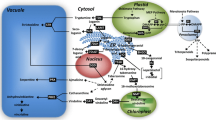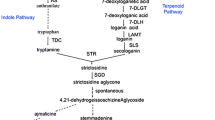Abstract
Two cytochrome P450 proteins, CYP79F1 and CYP79F2, are involved in the biosynthesis of aliphatic glucosinolates (GSs) in brassicaceous species. In order to increase aliphatic GS levels in Arabidopsis thaliana hairy root cultures (HRCs) with the aim of biomanufacturing GSs, CYP79F1 and CYP79F2 from either Arabidopsis thaliana or Brassica rapa were first constitutively expressed in stably transformed Arabidopsis plants, and then HRC was induced by additional transformation with Agrobacterium rhizogenes. Gene expression levels and GS profiles were analyzed in HRC in order to validate the impact on aliphatic levels. To estimate the potency of gene transformation on GS content in HRC, GS levels were compared to levels in roots and leaves of transformed plants. According to the data obtained, short-chain aliphatic GSs in plants were raised in three generations after transformation, indicating that expression of transgenes was stable. After HRC induction, transcript levels of CYP79F1 and CYP79F2 rose and short-chain aliphatic GS levels increased by as much as 7-fold compared to the respective HRC wild-type control. However, when compared to levels present in leaves and roots of plants before HRC induction, aliphatic GS levels in HRC remained very low. In addition, expression of CYP79F1 and CYP79F2 also enhanced the content of indole GSs, mainly indol-3-ylmethyl GS and 4-hydroxy-indol-3-ylmethyl GS in HRC. The results presented provide basic information about GS biosynthesis in HRC of Arabidopsis thaliana compared to intact plants, which will help scientists to further optimize GS composition in HRC in the future.





Similar content being viewed by others
Abbreviations
- GS:
-
Glucosinolate
- HRC:
-
Hairy root culture
- JA:
-
Jasmonic acid
References
Agerbirk N, Olsen CE (2012) Glucosinolate structures in evolution. Phytochem 77:16–45
Baasanjav-Gerber C, Monien BH, Mewis I, Schreiner M, Barillari J, Iori R, Glatt HR (2010) Identification of glucosinolate congeners able to form DNA adducts and to induce mutations upon activation by myrosinase. Mol Nutr Food Res 55:1–10
Baskar V, Gururani MA, Yu JW, Park SW (2012) Engineering glucosinolates in plants: current knowledge and potential uses. Appl Biochem Biotechnol 168:1694–1717
Brader G, Tas E, Palva ET (2001) Jasmonate-dependent induction of indole glucosinolates in Arabidopsis by culture filtrates of the nonspecific pathogen Erwinia carotovora. Plant Physiol 126:849–860
Brown PD, Tokuhisa JG, Reichelt M, Gershenzon J (2003) Variation of glucosinolate accumulation among different organs and developmental stages of Arabidopsis thaliana. Phytochem 62:471–481
Bulgakov VP (2008) Functions of rol genes in plant secondary metabolism. Biotechnol Adv 26:318–324
Cai Z, Kastell A, Knorr D, Smetanska I (2012) Exudation: an expanding technique for continuous production and release of secondary metabolites from plant cell suspension and hairy root cultures. Plant Cell Rep 31:461–477
Chen H, Nelson RS, Sherwood JL (1994) Enhanced recovery of transformants of Agrobacterium tumefaciens after freeze-thaw transformation and drug selection. Biotechniques 16:664–670
Chen SX, Glawischnig E, Jorgensen K, Naur P, Jorgensen B, Olsen CE, Hansen CH, Rasmussen H, Pickett JA, Halkier BA (2003) CYP79F1 and CYP79F2 have distinct functions in the biosynthesis of aliphatic glucosinolates in Arabidopsis. Plant J 33:923–937
Chen YZ, Pang QY, He Y, Zhu N, Branstrom I, Yan XF, Chen S (2012) Proteomics and metabolomics of Arabidopsis responses to perturbation of glucosinolate biosynthesis. Mol Plant 5:1138–1150
Clarke JD, Dashwood RH, Ho E (2008) Multi-targeted prevention of cancer by sulforaphane. Cancer Lett 269:291–304
Clough SJ, Bent AF (1998) Floral dip: a simplified method for Agrobacterium-mediated transformation of Arabidopsis thaliana. Plant J 16:735–743
Fahey JW, Zalcmann AT, Talalay P (2001) The chemical diversity and distribution of glucosinolates and isothiocyanates among plants. Phytochem 56:5–51
Georgiev MI, Pavlov AI, Bley T (2007) Hairy root type plant in vitro systems as sources of bioactive substances. Appl Microbiol Biotechnol 74:1175–1185
Georgiev MI, Agostini E, Ludwig-Muller J, Xu J (2012) Genetically transformed roots: from plant disease to biotechnological resource. Trends Biotechnol 30:528–537
Gigolashvili T, Berger B, Flügge UI (2009) Specific and coordinated control of indolic and aliphatic glucosinolate biosynthesis by R2R3-MYB transcription factors in Arabidopsis thaliana. Phytochem Rev 8:3–13
Grubb CD, Abel S (2006) Glucosinolate metabolism and its control. Trends Plant Sci 11:89–100
Haack M, Löwinger N, Lippmann D, Kipp A, Pagnotta E, Iori R, Monien BH, Glatt H, Brauer MN, Wessjohann LA, Brigelius-Flohé R (2010) Breakdown products of neoglucobrassicin inhibit activation of Nrf2 target genes mediated by myrosinase derived glucoraphanin hydrolysis products. Biol Chem 391:1281–1293
Halkier BA, Gershenzon J (2006) Biology and biochemistry of glucosinolates. Annu Rev Plant Biol 57:303–333
Hansen CH, Wittstock U, Olsen CE, Hick AJ, Pickett JA, Halkier BA (2001) Cytochrome P450CYP79F1 from Arabidopsis catalyzes the conversion of dihomomethionine and trihomomethionine to the corresponding aldoximes in the biosynthesis of aliphatic glucosinolates. J Biol Chem 276:11078–11085
Hayes JD, Kelleher MO, Eggleston IM (2008) The cancer chemopreventive actions of phytochemicals derived from glucosinolates. Eur J Nutr 47:73–88
Higdon JV, Delage B, Williams DE, Dashwood RH (2007) Cruciferous vegetables and human cancer risk: epidemiologic evidence and mechanistic basis. Pharmacol Res 55:224–236
Hirai MY, Sugiyama K, Sawada Y, Tohge T, Obayashi T, Suzuki A, Araki R, Sakurai N, Suzuki H, Aoki K, Goda H, Nishizawa OI, Shibata D, Saito K (2007) Omics-based identification of Arabidopsis Myb transcription factors regulating aliphatic glucosinolate biosynthesis. PNAS 104:6478–6483
Hoagland DR, Arnon DI (1950) The water-culture method for growing plants without soil. University of California Agricultural Experiment Station, Berkley
Karimi M, Inzé D, Depicker A (2002) GATEWAY(TM) vectors for Agrobacterium-mediated plant transformation. Trends Plant Sci 7:193–195
Kastell A, Smetanska I, Ulrichs C, Cai Z, Mewis I (2013a) Effects of phytohormones and jasmonic acid on glucosinolate content in hairy root cultures of Sinapis alba and Brassica rapa. Appl Biochem Biotechnol 169:624–635
Kastell A, Smetanska I, Schreiner M, Mewis I (2013b) Hairy roots, callus, and mature plants of Arabidopsis thaliana exhibit distinct glucosinolate and gene expression profiles. Plant Cell Tissue Org 115:45–54
Lippmann D, Lehmann C, Florian S, Barknowitz G, Haack M, Mewis I, Wiesner M, Schreiner M, Brigelius-Flohé R, Kipp AP (2014) Glucosinolates from pak choi and broccoli induce enzymes and inhibit inflammation and colon cancer differently. Food Funct. doi:10.1039/C3FO60676G
Livak KJ, Schmittgen TD (2001) Analysis of relative gene expression data using real-time quantitative PCR and the 2(T)(−Delta Delta C) method. Methods 25:402–408
Malitsky S, Blum E, Less H, Venger I, Elbaz M, Morin S, Eshed Y, Aharoni A (2008) The transcript and metabolite networks affected by the two clades of Arabidopsis glucosinolate biosynthesis regulators. Plant Physiol 148:2021–2049
Mewis I, Appel HM, Hom A, Raina R, Schultz JC (2005) Major signaling pathways modulate Arabidopsis glucosinolate accumulation and response to both phloem-feeding and chewing insects. Plant Physiol 138:1149–1162
Mikkelsen MD, Olsen CE, Halkier BA (2010) Production of the cancer-preventive glucoraphanin in tobacco. Mol Plant 3:751–759
Murillo G, Mehta RG (2001) Cruciferous vegetables and cancer prevention. Nutr Cancer 41:17–28
Murashige T, Skoog F (1962) A revised medium for rapid growth and bio assays with tobacco tissue cultures. Physiol Plant 15:473–497
Neave AS, Sarup SM, Seidelin M, Duus F et al (2005) Characterization of the N-methoxyindole-3-carbinol (NI3C)-induced cell cycle arrest in human colon cancer cell lines. Toxicol Sci 83:126–135
Ono NN, Tian L (2011) The multiplicity of hairy root cultures: prolific possibilities. Plant Sci 180:439–446
Park NI, Kim JK, Park WT, Cho JW, Lim YP, Park SU (2011) An efficient protocol for genetic transformation of watercress (Nasturtium officinale) using Agrobacterium rhizogenes. Mol Biol Rep 38:4947–4953
Reintanz B, Lehnen M, Reichelt M, Gershenzon J, Kowalczyk M, Sandberg G, Godde M, Uhl R, Palme K (2001) bus, a bushy Arabidopsis CYP79F1 knockout mutant with abolished synthesis of short-chain aliphatic glucosinolates. Plant Cell 13(2):351–367
Schreiner M, Krumbein A, Knorr D, Smetanska I (2011) Enhanced glucosinolates in root exudates of Brassica rapa ssp. rapa mediated by salicylic acid and methyl jasmonate. J Agric Food Chem 59:1400–1405
Sønderby IE, Geu-Flores F, Halkier BA (2010) Biosynthesis of glucosinolates—gene discovery and beyond. Trends Plant Sci 15:283–290
Staswick PE, Tiryaki I (2004) The oxylipin signal jasmonic acid is activated by an enzyme that conjugates it to isoleucine in Arabidopsis. Plant Cell 16:2117–2127
Textor S, de Kraker JW, Hause B, Gershenzon J, Tokuhisa JG (2007) MAM3 catalyzes the formation of all aliphatic glucosinolate chain lengths in Arabidopsis. Plant Physiol 144:60–71
van Dam NM, Witjes L, Svatos A (2003) Interactions between aboveground and belowground induction of glucosinolates in two wild Brassica species. New Phytol 161:801–810
Weng JR, Tsai CH, Kulp SK, Chen CS (2008) Indole-3-carbinol as a chemopreventive and anti-cancer agent. Canc Lett 262:153–163
Wielanek M, Urbanek H (1999) Glucotropaeolin and myrosinase production in hairy root cultures of Tropaeolum majus. Plant Cell Tissue Org 57:39–45
Wielanek M, Krolicka A, Bergier K, Gajewska E, Sklodowska M (2009) Transformation of Nasturtium officinale, Barbarea verna and Arabis caucasica for hairy roots and glucosinolate-myrosinase system production. Biotechnol Lett 31:917–921
Zang YX, Kim JH, Park YD, Kim DH, Hong SB (2008) Metabolic engineering of aliphatic glucosinolates in Chinese cabbage plants expressing Arabidopsis MAM1, CYP79F1, and CYP83A1. BMB Rep 41:472–478
Zang YX, Kim DH, Park BS, Hong SB (2009) Metabolic engineering of indole glucosinolates in Chinese cabbage hairy roots expressing Arabidopsis CYP79B2, CYP79B3, and CYP83B1. Biotechnol Bioproc Eng 14:467–473
Acknowledgments
This work was funded by the German Federal Ministry of Education and Research, Grant No. FKZ: 0315370B/A, for which we are very grateful. We would also like to thank Professor Dietrich Knorr from the Berlin University of Technology for supporting this work. We also thank Irene Hemmerich from the Berlin University of Technology and Andrea Maikath from the Leibniz Institute of Vegetable and Ornamental Crops Großbeeren for the technical assistance they provided. We are also grateful to Professor David Tepfer INRA, France, for providing the A4 strain.
Author information
Authors and Affiliations
Corresponding author
Electronic Supplementary Material
Below is the link to the electronic supplementary material.
Online Resource 1
(PDF 1666 kb)
Online Resource 2
(PDF 158 kb)
Online Resource 3
(PDF 17 kb)
Online Resource 4
(PDF 73 kb)
Rights and permissions
About this article
Cite this article
Kastell, A., Zrenner, R., Schreiner, M. et al. Metabolic Engineering of Aliphatic Glucosinolates in Hairy Root Cultures of Arabidopsis thaliana . Plant Mol Biol Rep 33, 598–608 (2015). https://doi.org/10.1007/s11105-014-0781-6
Published:
Issue Date:
DOI: https://doi.org/10.1007/s11105-014-0781-6




